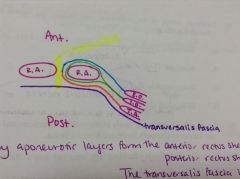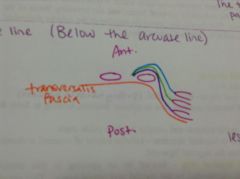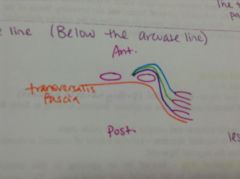![]()
![]()
![]()
Use LEFT and RIGHT arrow keys to navigate between flashcards;
Use UP and DOWN arrow keys to flip the card;
H to show hint;
A reads text to speech;
44 Cards in this Set
- Front
- Back
|
What are the 9 different regions of the abdomen?
|
1. Left hypochondriac
2. Epigastric 3. Right hypochondriac 4. Left lateral 5. Umbilical 6. Right lateral 7. Left inguinal 8. Pubic 9. Right inguinal |
|
|
What planes create the 9 regions?
|
-subcostal plane (through L3)
-intertubercular plane (at L5 level) -2 vertical planes that run down the midpoint of each clavicle |
|
|
What are the 4 quadrants of the abdomen?
|
-R upper quadrant
-L upper quadrant -R lower quadrant -L lower quadrant Two planes go through the umbilicus. |
|
|
What are the surface features of the abdominal wall?
|
-linea semilunaris
-inguinal groove -iliac crest -umbilicus -linea alba |
|
|
Where is the linea semilunaris?
|
"Line like a moon", lateral border of the rectus abdominis
|
|
|
Where is the inguinal groove?
|
Overlies the inguinal ligament, V shape
|
|
|
Where is the linea alba?
|
Right down the middle of the rectus abdominis muscles. Clinically significant, is a place with no nerves or blood supply, surgeons will use this as an incision line.
|
|
|
What are the cutaneous nerves of the abdominal wall?
|
-intercostal (T7-T11)
-subcostal (T12) -iliohypogastric (L1) -ilioinguinal (L1) JUST CUTANEOUS |
|
|
Which of the cutaneous nerves are mixed?
|
Intercostal, subcostal and iliohypogastric nerves.
|
|
|
What is Camper's fascia?
|
The outer fatty layer just deep to the skin.
|
|
|
What is Scarpa's fascia?
|
The inner membranous layer, continuous with fascia lata of the thigh, the superficial perineal fascia, and the investing fascia of the penis and scrotum.
Covers the muscles of the anterior abdominal wall, deep to Camper's fascia. |
|
|
What is the external abdominal oblique?
|
O: ribs 5-12
I: pubic tubercle and anterior 1/2 of the pubic crest Inv: motor fibers in T7-T12 and iliohypogastric n. Orientation of fibers are inferomedial (putting hands in pockets) |
|
|
What is the superficial inguinal ring?
|
Formed by an opening in the aponeuroses of the external abdominal oblique.
|
|
|
What does the superficial inguinal ring transmit?
|
Transmits the spermatic cord in the male and the round ligament of the uterus in the female. Also the ilioinguinal n. passes through.
|
|
|
What is the internal abdominal oblique?
|
O: thoracolumbar fascia, anterior 2/3rds of the iliac crest and lateral 2/3rds of the inguinal ligament
I: ribs 10-12, linea alba, conjoint tendon which is attached to the pubic crest and the pecten pubis. Inv: motor fibers T7-T12, iliohypogastric n., ilioinguinal n. Orientation of fibers is superomedial, transverse and inferomedial (fans out) |
|
|
What is the cremasteric muscle?
|
Surrounds the spermatic cord in the male, formed by the inferior fibers of the internal abdominal oblique. Keeps the testes at the proper temperature by con
|
|
|
What is the function of the cremasteric muscle?
|
Keeps the testes at the proper temperature by contracting and bringing the testes up when exposed to cold, relaxes on warm days.
|
|
|
What is the transversus abdominis?
|
O: costal cartilages 5-10, thoracolumbar fascia, iliac crest, lateral 1/3 of the inguinal ligament
I: linea alba and conjoint tendon Inv: motor fibers in T7-T12, iliohypogastric n., ilioinguinal n. |
|
|
What is the rectus abdominis?
|
O: pubic crest and pubic symphysis
I: xiphoid process and costal cartilages 5-7 Inv: T7-T11 and subcostal n. |
|
|
What are the actions of the abdominal muscles?
|
-Stabilizes the pelvis during walking
-Depress (lowers) the ribs -Tense the abdominal wall, increasing abdominal pressure -Flex the trunk, press organs |
|
|
What is the rectus sheath?
|
Surrounds the rectus abdominis on anterior and posterior surfaces.
|
|
|
What does the rectus sheath look like above the arcuate line on the anterior wall?
|

Formed by the deep fascia of external and internal abdominal oblique.
|
|
|
What does the rectus sheath look like below the arcuate line on the anterior wall?
|

Formed by the deep fascia of all three layers of abdominal muscles.
|
|
|
What does the rectus sheath look like above the arcuate line on the posterior wall?
|

Formed by the deep fascia of the internal abdominal oblique and the transversus abdominis.
|
|
|
What does the rectus sheath look like below the arcuate line on the posterior wall?
|

Formed by the transversals fascia only.
|
|
|
What is the pyramidalis?
|
A muscle that is not present in all individuals, is deep to the anterior layer of the rectus sheath, just anterior to inferior portion of the rectus abdominis.
Originates at the pubic crest and inserts on the linea alba. |
|
|
What is the blood supply to the rectus abdominis?
|
-superior epigastric a. and v. (from the internal thoracic vessels)
-inferior epigastric a. and v. (branch of the external iliac artery) |
|
|
What supplies blood to the other abdominal muscles?
|
Branches of the abdominal aorta.
|
|
|
What are the lymphatics of the anterior abdominal wall?
|
Areas superior to the umbilicus drain to the axillary nodes.
Areas inferior to the umbilicus drain to the inguinal nodes. |
|
|
What is on the internal surface of the anterior abdominal wall?
|
-falciform ligament
-lateral umbilical folds -medial umbilical folds -median umbilical fold |
|
|
What is the falciform ligament?
|
Located in the midline superior to the umbilicus, attaches the liver to the anterior abdominal wall. Contains the ligamentum teres, which is the obliterated umbilical vein).
|
|
|
What are the lateral umbilical folds?
|
Contain the inferior epigastric vessels.
|
|
|
What are the medial umbilical folds?
|
Cover the medial umbilical ligaments, which used to be the 2 umbilical arteries.
|
|
|
What is the median umbilical fold?
|
Covers the median umbilical ligament.
|
|
|
What are the contents of the inguinal canal in a male?
|
-ilioinguinal nerve
-spermatic cord -vas deferens -artery of the vas deferens -testicular artery -pampiniform plexus -lymphatics -genital branch of genitofemoral nerve |
|
|
What are the contents of the inguinal canal in a female?
|
-genital branch of the genitofemoral nerve
-ilioinguinal nerve -round ligament of the uterus |
|
|
What are the boundaries of the inguinal triangle?
|
AKA Hasselbach's triangle.
Lateral - inferior epigastric vessels Medial - lateral border of rectus abdominis Inferior - inguinal ligament |
|
|
What are acquired inguinal hernias?
|
Occur when a defect in the anterior abdominal wall develops and a loop or segment of the small intestine protrudes into the inguinal canal.
|
|
|
What happens to the hernia over time?
|
It becomes more severe, and a herniated bowel can eventually extend into the scrotal sac in the male, after passing through the superficial inguinal ring.
|
|
|
What can predispose people to inguinal hernias?
|
Occupations which require lifting of heavy objects and/or increased intra-abdominal pressure predispose some individuals to inguinal hernias. Pregnancy can lead to one as well, d/t increased intra-abdominal pressure generated when pushing the child through the birth canal.
|
|
|
What is a direct inguinal hernia?
|
Passes through the inguinal triangle, medial to the inferior epigastric vessels, to penetrate the posterior wall of the inguinal canal.
|
|
|
What is an indirect inguinal hernia?
|
More common. Passes through the deep inguinal ring lateral to the inferior epigastric vessels.
|
|
|
What kind of hernias are more common in men? Women?
|
Inguinal hernias are 3 times more likely in men.
Femoral hernias are more frequent in women. |
|
|
What is a strangulated hernia?
|
Needs emergency surgery or you will have necrosis of small intestine.
|

